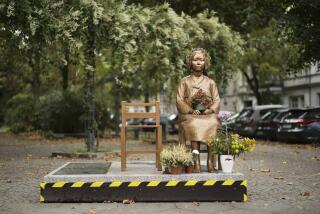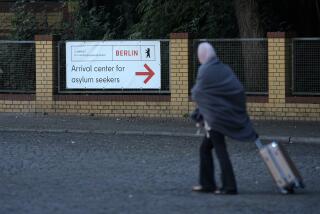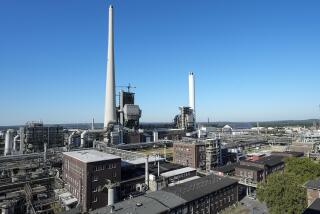Here’s How to Shrink Boom-Town Berlin Costs
- Share via
BERLIN — The guy is dressed entirely in black, his closely cropped hair half yellow, half pink. Definitely West.
The woman is in artificially faded jeans and an old West German military jacket. An Ossie for sure. Wrong both times.
The new Berlin’s latest bar game is deceptively easy. Old stereotypes about the differences between East and West German looks are fading as fast as you can say “consumer society.”
The old Berlin was a constant reminder of the pain and division of Germany--one people, two cities, separated by a concrete eyesore winding its way through the center of Germany’s greatest metropolis.
In much of the center city, the Wall has been removed--although, contrary to the simplified view of the world presented by television, miles of Wall still stand. And Berlin remains two very different places--which, for travelers, is the only fact that saves the city from pricing itself out of consideration.
Western Berlin is a boom town. Prices know no limit. Think of New York in the late ‘70s. Hotels, restaurants and bars know they can charge virtually anything and get away with it.
West Berlin’s taxi prices, among the highest in the world, are now in force in the east as well (although, for the first time, you can now find a cab in the east). But the city has an excellent, if expensive, public transit system, and connections between east and west are being added every month. (A single ride on the underground or streetcars costs about $2, but tourists can buy a 24-hour unlimited travel ticket for $6.)
And German reunification has revolutionized air travel to Berlin, allowing Lufthansa, which was banned from the city while it was still under Allied control, to take over, forcing out some carriers and requiring others to boost their prices by 50% to 100%.
Luckily, there are ways around much of this. Lufthansa, which is controlled by the German government, dramatically reduced the service and convenience of flights to Berlin from other German cities. British Airways subsequently increased its Berlin fares and eliminated the more affordable coach class on many flights. But you can still get low fares on BA by booking a week in advance and staying through a Saturday night.
And once you’re on the ground, you can combine the lower standard of living in the east with the surprising affordability of parts of western Berlin to keep the vacation tab within somewhat reasonable limits.
Most of Berlin’s sights are free or nearly so. In addition to the Wall (a long stretch of which has been turned into a delightful gallery of political art) and other relics of the Cold War, the city has a wealth of museums, historical monuments, grand parks and imperial palaces.
The Soviet War Memorial at Treptow in the east is a must-see, along with the constant parades of Red Army vehicles, one of many reminders that change comes more slowly in reality than on CNN.
Most of the stately old structures on the east’s Museum Island are hidden behind scaffolding these days, as western renovators begin to make up for 40 years of neglect. From the Pergamon Museum’s remarkable altar to the Bode’s collection of Near Eastern and Byzantine works, the riches once hidden behind the Iron Curtain are worth a day or more.
Berlin also boasts two cities’ worth of theaters, concert halls and movie houses, although those in the east are suffering from the economic crisis there, as eastern Berliners, struggling to afford western food prices, find the old state-subsidized arts prices are also a matter of history.
Opera, theater and music directors say the oversupply of productions probably will last only one more year, but before the wave of mergers and closings is finished, tourists will find plenty of empty seats--often at half the price of similar U.S. shows.
Try the Comic Opera, the State Opera and the splendid halls at the Plaza of the Academy, all in the eastern part of the city. There were never enough hotel rooms in Berlin, and there are no more now that the city has become a window onto suddenly sexy Eastern Europe. So the big business hotels have jacked up prices to levels affordable only to those with overstuffed bank or expense accounts.
At the big chain hotels, double rooms are now routinely in the $250 to $600 range. This is as true in the east as in the west, and the east still has major disadvantages (the phones don’t work, the air reeks of brown coal during cold months, the food is generally odious.)
But western Berlin has a wealth of small hotels and pensions, many of them in prewar buildings with high ceilings, drafty windows and an overwhelming sense of brown--the somewhat dowdy look that teases the imagination with a bit of ‘20s decadence. The tourist center at the Europa Center in the west will find you a room at a pension or bed and breakfast. The old East German Reiseburo on Alexanderplatz is still in operation, and will book you in a bedroom in someone’s private apartment for a modest sum.
Pensions like Bialas (Carmerstrasse 16) are small but clean and offer double rooms in the $60 to $100 range, with the price varying according to how particular you are about having a bathroom to yourself. Another possibility in this class, a bit more expensive, is the Eremitage Hotel (Schlueterstrasse 54), which has rooms with brocade curtains and creaking closets, the Old World look that populated Christopher Isherwood’s “Berlin Stories.”
Further up the price ladder are small hotels such as Fruehling am Zoo (Kurfuerstendamm 17), where doubles range from $80 to $130, or the Curator, a post-modern place (Grolmanstrasse 41-43) where all doubles cost about $160, including breakfast.
A more adventurous and vastly cheaper route is to stay with east Berliners who rent bedrooms, often giving up their own rooms to earn some extra money during this transitional phase of high unemployment and soaring prices.
Most German bookstores offer thick lists of private quarters in Berlin and other eastern cities. This is a no-frills approach, but it offers a window on the rapidly changing eastern life, where brand-new VCRs and color TVs sit beside coal stoves and the omnipresent Communist-design beige plastic furniture.
Food and drink can be shockingly pricey in the west, and the quality of cooking in the east has not improved markedly despite the new availability of western ingredients. But there are interesting hangouts in the east; some are overrun by “Wessies,” although some retain their old customers.
Zur Letzten Instanz (Waisenstrasse 14) behind the old East German courts, now part of the united Berlin government, is a century-old lawyers’ retreat. The name means “at the last appeal,” and the crowd is a mix of eastern judges who lost their jobs when their country ceased to exist, western hotshots trying to make it big pioneering in the east and the usual bunch of courthouse characters.
In the working-class district of Prenzlauerberg, the center of Berlin radicalism for a century, a walk up Schoenhauser Allee, a bustling street of new shops and shuttered relics of the planned economy, new restaurants and old corner bars reveal the mix of east and west that Berliners are trying to put together.
Eating can be cheap in the west if you discover the neighborhoods frequented by the legions of young West Germans who migrated to the walled city over the past decades, either to avoid the draft, assert their distance from the conformity of West German life, or join the various alternative scenes offered by anarchists, artists and others who relished the seclusion provided by the Wall.
In addition to the traditional Berlin cafes such as Kranzler’s on the Kurfuerstendamm, where blue-haired ladies sit with Kaffee and Kuchen, there are student cafes such as Luise (Koniginluisestr 40) in Dahlem, which offers beer and fairly good food (breakfast till 3 p.m.) for little money.
Here are some other affordable bars and restaurants that offer something special. One warning: All Berlin bars and restaurants are dramatically more smoky than anything Americans are likely to encounter back home. Virtually everyone smokes and there is little if any effort to change the air.
--Loretta am Wannsee (Kronprinzessinnenweg 260) is a sprawling beer garden near the spectacular lake on the outskirts of the city. Serving breakfast till 1 p.m., Loretta has 100 tables under big old trees. The menu is mostly pretzels and wurst, and in classic German manner, a glass of water costs about $2.10 and beer $1.80. There’s a playground for children and an indoor restaurant filled with traditionally dressed older folks taking their afternoon Kaffee.
--Max und Moritz (Oranienstrasse 162) is an old Berlin Kneipe with a huge bar and high ceilings. Named after two traditional bad-boy cartoon characters, Max und Moritz offers typically thick German soups and other such heavy but relatively cheap fare.
--Leydicke (Mansteinstrasse 4) offers a mix of yuppies and black-clad alternativ Szene aficionados, who gather in a 100-year-old family business to sit with glasses of home-brewed fruit wines and liquors that come in flavors from kiwi to peach to strawberry, all of them sickly sweet.
--Cafe M (Goltzstrasse 33) is a neon Kneipe. Formerly known as Cafe Mitropa, it had to change its name after the old East German Reichsbahn railroad complained that the hip Western bar was damaging the reputation of their Mitropa railroad-station cafes. Probably it was the other way around. Cafe M is aggressively hip, with music ranging from Vivaldi to bossa nova to hip-hop. Cafe M has a metal floor, tiled walls and a ‘60s bar. Wear black.
--Henne (on Leuschnerdamm, a street in the funky Kreuzberg section where the Wall stood until last year) is a rarity in Germany, a restaurant that specializes in chicken--a food that Germans generally do not eat. Henne sells nothing but corn-fed chickens, which cost about $6 grilled. The place is always packed.
Across the street from the Kaiser’s Schloss Charlottenberg is a local brewery with its own Bavarian-style beer garden. Luisenbraeu has long tables and benches where you sit while waitresses bring full trays of the home brew. You don’t order; you automatically get a beer unless you put your Deckel (coaster) over the top of your glass. The waitress keeps score of your drinking with pencil marks across your Deckel. There’s plenty of food, too.
For more information, contact the German National Tourist Office, 444 S. Flower St., Suite 2230, Los Angeles 90071, (213) 688-7332. Also: the Berlin Desk, 767 Fifth Ave., 16th Floor, New York 10153, (212) 705-1371.
More to Read
Sign up for The Wild
We’ll help you find the best places to hike, bike and run, as well as the perfect silent spots for meditation and yoga.
You may occasionally receive promotional content from the Los Angeles Times.






